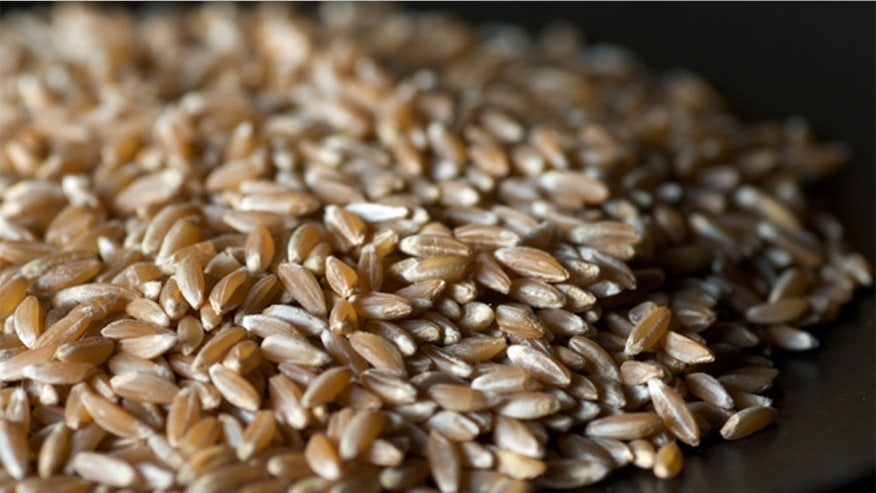
Ancient grains like farro are part of a growing industry for alternative foods. (iStock)
Man first cultivated grain roughly 10,000 years ago, letting him diversify his Quest for Fire diet of animal parts, seeds and berries. Now those selfsame “ancient grains” are staging a comeback.
Ancient grains like farro, freekah and kamut are early strains of wheat. Chia, quinoa and amaranth are technically seeds, but they’re generally called “grains” and are popping up in everything from pizza to pasta to cookies to chips.
“Americans will spend $1.5 trillion dollars on food this year.”
– Harry Balzer, chief food industry analyst for the NPD Group
Harry Balzer, chief food industry analyst for the NPD Group, a consumer marketing research firm, says ancient grains are all about the money. “Americans will spend $1.5 trillion dollars on food this year,” he says, and ancient grains are one way industries can “grow that market to get their share.”
Recipe: Creamy Farro with Honey-Roasted Grapes
A few millennia before Christ, Egyptians created a slice of that market when they added yeast to wheat and invented leavened bread. Legend has it that after he conquered Egypt, Julius Caesar called the wheat “pharaoh’s wheat” (thus the name “farro”), and it became part of his soldiers’ rations. The Romans prized farro bread so highly that the bakers were free men, while all other artisans were slaves.
Grains flourished for millennia until the Atkins and Paleo diets turned the staff of life into a buzz-kill. Celiac disease, GMO issues, bestsellers like Wheat Belly: Lose the Wheat, Lose the Weight (Rodale), even gluten-free dog food added to grains’ hero-to-zero free-fall. Wheat became the new chaff.
Recipe: Wheat Berry Fools with Grand Marnier Figs
But high-protein diets are notoriously hard to maintain, because people crave carbs. So now people are looking for new ones.
Nutrient-dense, genetically unmodified, low- and no-gluten ancient grains may satisfy that craving. They’re high in protein and fiber, and they contain healthy fats, magnesium, potassium, calcium and folate. Amaranth, chia and quinoa are complete proteins. Amaranth even has vitamin C.
Judith Finlayson, author of The Complete Whole Grains Cookbook, says ancient grains could generate a new trend in “nutrient-counting.”
“We’ve done ourselves a great disservice by focusing on calories at the expense of nutrition,” she says, noting that the “right” calorie count can still leave you nutritionally deficient.
Finlayson’s books, Maria Baez Kijac’s Cooking with Ancient Grains (Adams Media) and Maria Speck’s Ancient Grains for Modern Meals (Ten Speed Press) and her upcoming Simply Ancient Grains are all well-researched resources.
Although gluten-intolerant, Finlayson is still pro-wheat, calling it a tremendously healthy grain “that historically provided a lot of nutrients to people who needed them.”
She’s become a big fan of millet, which you may know as bird food. (If you’ve seen a bird feeder, you’ve seen millet.) Ancient Romans ate it, and the Ethiopian bread staple injera is made from a millet variety called teff.
Millet is high in nutrition, and growing it requires fewer water and soil nutrients than other cereals.
Kijac, a food historian, focuses on the gluten-free “superfoods” of the Aztecs and Mayans: quinoa, amaranth, chia and kaniwa. She sees their growing popularity as “the rediscovery of an arc of food that almost disappeared.”
She thinks chia will overtake quinoa in popularity because it requires little or no cooking and is extremely high in fiber. Kijac’s words to the wise: “Start cautiously and in small amounts.”
Bob’s Red Mill “Grains of Discovery” line sells most “ancient grains,” while rolandfood.com has hard-to-find kaniwa. Amazon has oddly named Job’s Tears.
Despite the hoopla, ancient grains are still off-radar. “Less than 2 percent of Americans will eat quinoa this week,” Balzer says, while “44 percent will eat cake.”
But Americans’ affection for new experiences could change that metric.
Since ancient grains are anchored to existing products like bread, cereal and mixes, they’re an easy sell, Balzer says. Tasting a “new” version of something you already know provides an experience “that’s unlikely to make you starve or die,” he says. That’s a solid low-risk, high-reward return.
Though ancient grains are expensive – a 16-ounce bag of quinoa sells for about $9 – they’ll seem cost-effective if people see them as a high-protein substitute for meat, Balzer says.
So ancient grains could last for a few more millennia, or they could be gone faster than you can say “rice cakes.” Time will tell.

